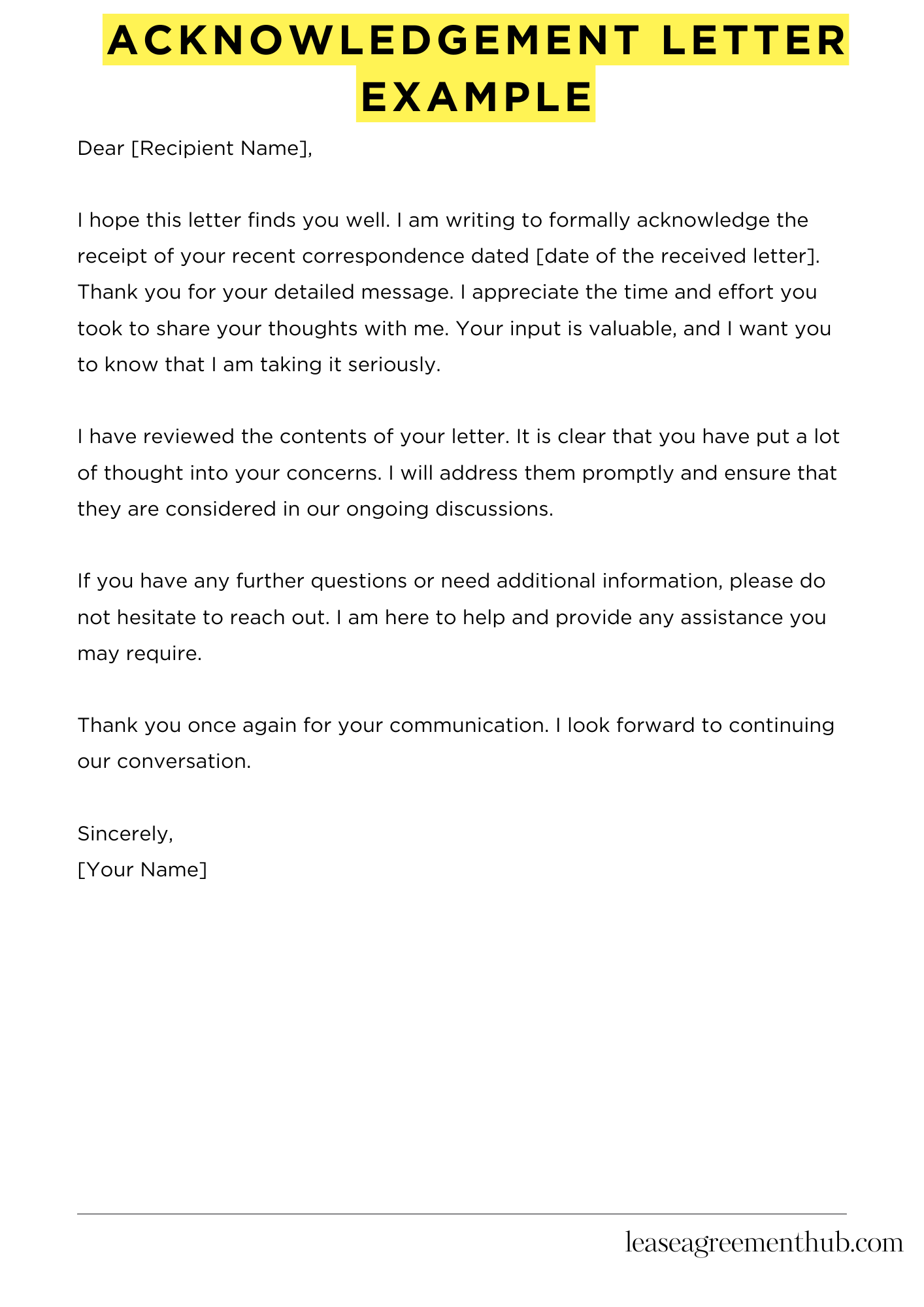An acknowledgment letter is a formal way to confirm the receipt of something, such as a document, payment, or application. Its purpose is to assure the sender that their item has been received and is being processed. This helps maintain clear communication and builds trust between parties.
In this article, we will provide various templates and examples of acknowledgment letters. These samples will guide you in crafting your own letters. Whether you need to acknowledge a job application, a donation, or any other correspondence, we have you covered.
By using our examples, you can save time and effort. Writing an acknowledgment letter becomes simple and straightforward. You’ll be able to express your appreciation and confirm receipt effectively.
Acknowledgement Letter Example
[Your Name]
[Your Address]
[City, State, Zip Code]
[Email Address]
[Phone Number]
[Date]
[Recipient Name]
[Recipient Title]
[Company Name]
[Company Address]
[City, State, Zip Code]
Dear [Recipient Name],
I hope this letter finds you well. I am writing to formally acknowledge the receipt of your recent correspondence dated [date of the received letter].
Thank you for your detailed message. I appreciate the time and effort you took to share your thoughts with me. Your input is valuable, and I want you to know that I am taking it seriously.
I have reviewed the contents of your letter. It is clear that you have put a lot of thought into your concerns. I will address them promptly and ensure that they are considered in our ongoing discussions.
If you have any further questions or need additional information, please do not hesitate to reach out. I am here to help and provide any assistance you may require.
Thank you once again for your communication. I look forward to continuing our conversation.
Sincerely,
[Your Name]

How to Write Acknowledgement Letter Example
An acknowledgement letter is a formal way to confirm receipt of something. It can be a document, a gift, a request, or even a complaint. It’s a simple yet powerful tool for communication, ensuring everyone is on the same page.
Why Write an Acknowledgement Letter?
Acknowledgement letters serve several purposes. They show professionalism and courtesy. They provide a written record of communication. And they can be used to clarify details or set expectations.
Key Elements of an Acknowledgement Letter
A well-written acknowledgement letter should include the following:
- Your Name and Contact Information: This helps the recipient know who sent the letter.
- Date: This provides a timestamp for the letter.
- Recipient’s Name and Contact Information: This ensures the letter reaches the intended recipient.
- Subject Line: This clearly states the purpose of the letter.
- Acknowledgement Statement: This is the main part of the letter, where you acknowledge the receipt of the item or information. Be specific about what you are acknowledging.
- Optional Information: You can include additional information, such as a brief summary of the contents, a timeline for further action, or a thank you.
- Closing: Use a professional closing, such as “Sincerely” or “Regards.”
- Your Signature: Sign your name legibly.
Acknowledgement Letter Example
Here’s an example of an acknowledgement letter for a job application:
Dear [Hiring Manager Name],
This letter acknowledges receipt of your job application for the [Job Title] position at [Company Name]. We appreciate your interest in our company and will review your application carefully.
We will be in touch within [Number] weeks to schedule an interview if your qualifications align with our needs.
Thank you for your time and consideration.
Sincerely,
[Your Name]
Tips for Writing an Effective Acknowledgement Letter
Here are some tips to help you write a great acknowledgement letter:
- Be Concise and Clear: Get to the point quickly and avoid unnecessary details.
- Be Professional: Use formal language and a professional tone.
- Be Timely: Respond promptly to avoid delays and maintain good communication.
- Proofread Carefully: Ensure there are no errors in grammar or spelling.
By following these tips, you can write effective acknowledgement letters that demonstrate professionalism and maintain good communication.
Related: